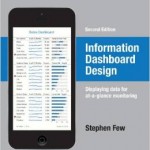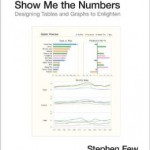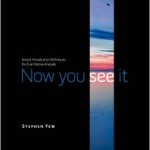I recently finished the book Now You See It: Simple Visualization Techniques for Quantitative Analysis by Stephen Few of Perceptual Edge. Stephen Few is a data visualization guru and his books about designed visualizations has changed my career in BI and how I develop reports and dashboards. Few currently has three books published (with a fourth on its way):
- Show Me the Numbers: Designing Tables and Graphs to Enlighten, which has already 2 editions.
- Information Dashboard Design, which also has 2 published editions.
- Now You See It: Simple Visualization Techniques for Quantitative Analysis
I'm a huge fan of Few's work and this blog post is meant as an introduction to his different titles, so people know what to expect when they read one of his books. I'll review each of them in the order that I've read them (which actually has no specific meaning).
Information Dashboard Design
 This book really opened my eyes regarding data visualization best practices. I read the first edition, of which you can find my review here. I ordered the second edition the day it came out; the book is that good.
This book really opened my eyes regarding data visualization best practices. I read the first edition, of which you can find my review here. I ordered the second edition the day it came out; the book is that good.
As the title says, this book explains how to design dashboards efficiently. It introduces you to the principles of visual perception and how you can use those to make better dashboards. It also gives plenty examples of bad and good dashboard design.
Even though its focus is on dashboards, a lot of the design principles are true for regular reports and visualizations as well. I could apply them immediately at my job when creating SSRS reports.
Show me the Numbers
 After reading Information Dashboard Design, I thought: "Great, now I know how to design dashboards and charts, but what about tables?" This book is the answer to that question. It gives a full overview on how to design data visualizations, be it tables or graphs. There are even some exercises in the book.
After reading Information Dashboard Design, I thought: "Great, now I know how to design dashboards and charts, but what about tables?" This book is the answer to that question. It gives a full overview on how to design data visualizations, be it tables or graphs. There are even some exercises in the book.
This makes the book more complete than Information Dashboard Design. There is in fact quite some considerable overlap between the two books. If you want to buy only one book about data visualization, I recommend this one. If you are interested in dashboards only and how multiple graphs can interact on one page, then get the other book.
There are also some interesting appendices to this book, such as adjusting for inflation and how to create some chart types in Excel.
Now you see it
 The final book is a bit more different. While the other two books focus more on how to create data visualizations, this book goes into more detail on what you should do with those visualizations and why purpose they can serve.
The final book is a bit more different. While the other two books focus more on how to create data visualizations, this book goes into more detail on what you should do with those visualizations and why purpose they can serve.
This book is meant for people using visualizations for analytic purposes. It describes what characteristics analysts should have, what kind of analytical interaction and navigation there is and how analytical software should support it. Very interesting to read, because even 6 years after this book has been published, not a single software product supports all of those features.
It also describes analytical techniques such as using reference lines, reducing overplotting and using trellises. The book then talks about patterns and then details all the different types of relationships: time-series, ranking, deviation, distribution, correlation and multivariate analysis. Most of the time examples were made using Excel, Tableau or Spotfire.
All in all a very interesting book to read. I definitely recommend it for people who have to analyze data as part of their job.





